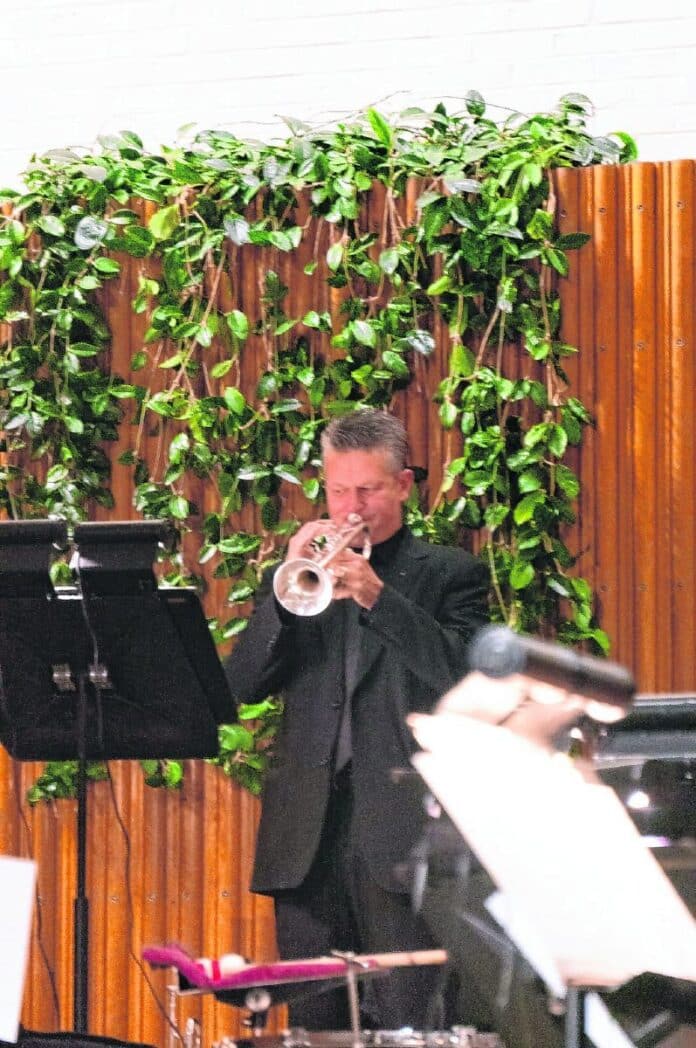
Saturday’s Columbus Indiana Philharmonic concert was titled “Comfort and Joy,” aptly named by conductor/artistic director David Bowden considering the political and pandemic anxieties of the moment.
The venue was Eliel Saarinen’s magnificent downtown edifice of First Christian Church with its sumptuous acoustics and one-of-a-kind Aeolian–Skinner organ. From the first note — a super-low B-flat on the organ introducing Richard Strauss’s “Solemn Processional of the Knights,” the seven-piece brass section and tympani entered and the piece grew in ever-increasing volume to a mighty climax, and the audience knew we were on our way.
In keeping with the times, this scaled-down orchestra consisted only of a brass section, a string quintet, two oboes, tympani, and the organ. The musicians were the principal chairs of the orchestra. The organist was Lisa Lohmeyer, who plays services at First Christian. All players were appropriately spaced and wearing masks, as was the audience.
Even the oboes had little masks over their bells.
Anticipating a more subtle beginning to Charles-Marie Widor’s “Lord, Save the People,” we were suddenly enwrapped with full sounds from the organ. A stately yet solemn work for organ, brass, and tympani written during World War I, it emanates sadness, yet with a comforting resolve. It was beautifully performed.
At this point, the strings and oboes joined with the two piccolo trumpets and oboes in the most popular of the four published orchestral suites of J.S. Bach, the third suite. This one is particularly famous for its second movement — an Air on G string.
Unfortunately, the group had a problem getting into the baroque rhythm of the overture with its dotted notes associated with French overtures. But, the Air was superb.
Often played as solos at weddings and other occasions, it is in the context of the suite where we see the genius of Bach as a composer. For this is not just a solo for the first violin as the accompaniment consists of linear melodic lines in contrapuntal style that alternate between the other players and the soloist.
Of particular note was a section where the solo violin played by concertmaster, Daniel Aizenshtadt and the principal cellist, SeungAh Hong, were in dialogue — and you could feel the chemistry between these two young, very talented performers as they executed this passage with perfection and beauty.
As often transpires, the musical energy that was created among all the players in this movement transferred to the remaining three dances which were played with exuberance.
When the brass moved to the church loft, we had the rare opportunity to hear brass and organ playing antiphonally across a large space. Giovanni Gabrieli wrote several of these pieces for performance in St. Mark’s Cathedral, Venice, Italy with its spacious acoustics. First Christian Church is one of a few venues that can emulate this environment.
The organ plays a phrase that is answered by the brass and back and forth they go, filling the room in sound seemingly from all directions as it bounces off the walls. Based on a specific mode, this work, “Canzon Duodecimi Toni” would have presented a different sonority if played in the mean-tone tuning system of the time. But, it is just as effective in today’s equal temperament, and the audience appreciated this experience.
“The Grand Choeur Dialogue” by Eugène Gigout was the highlight of the concert. This work for organ, brass, and tympani comes close to being a concerto for organ brass and tympani. A piece with rich sonorities and a virtuosic organ part, the energy and precision of Lohmeyer’s playing drew out the best in the brass and tympani and the dialogue between them carried the work to a glorious conclusion which elicited a standing ovation from the audience for Lisa and all.
The concert concluded with the well-known joyful celebration “La Rejouissance” from Handel’s “Music for the Royal Fireworks.” This was the one work that involved the total ensemble and was perfect to wrap up this evening of diverse compositions that, to all who were present, conveyed joy and comfort attributable to the great music played by great musicians led by a great conductor.




